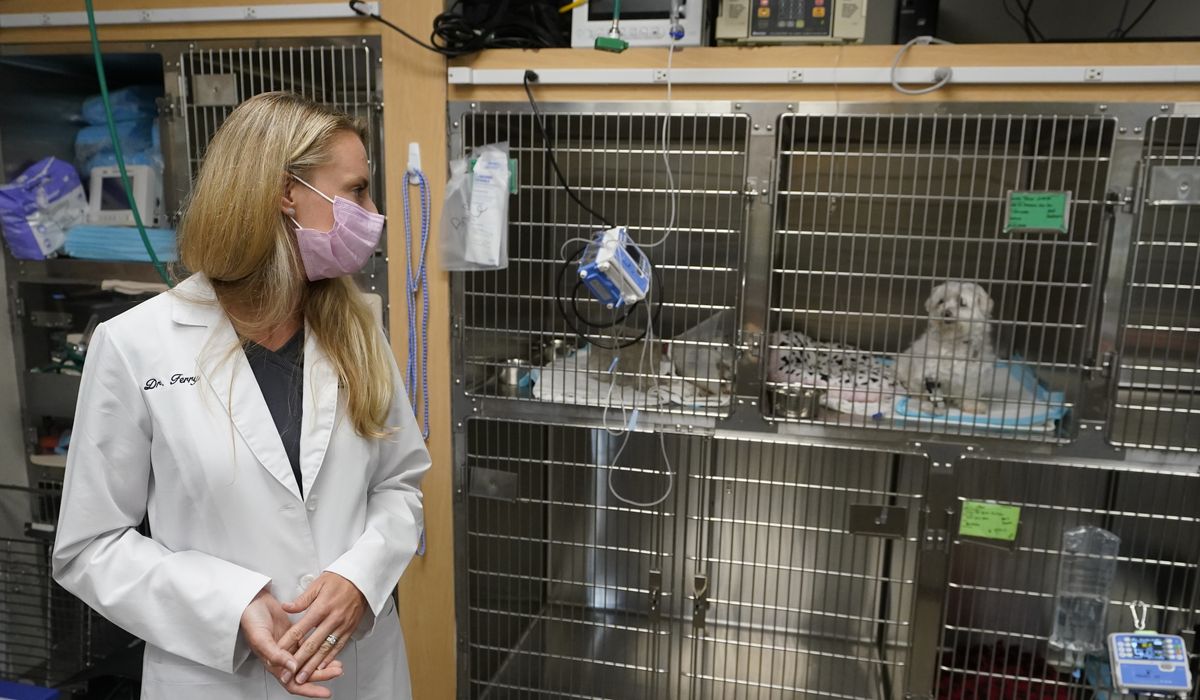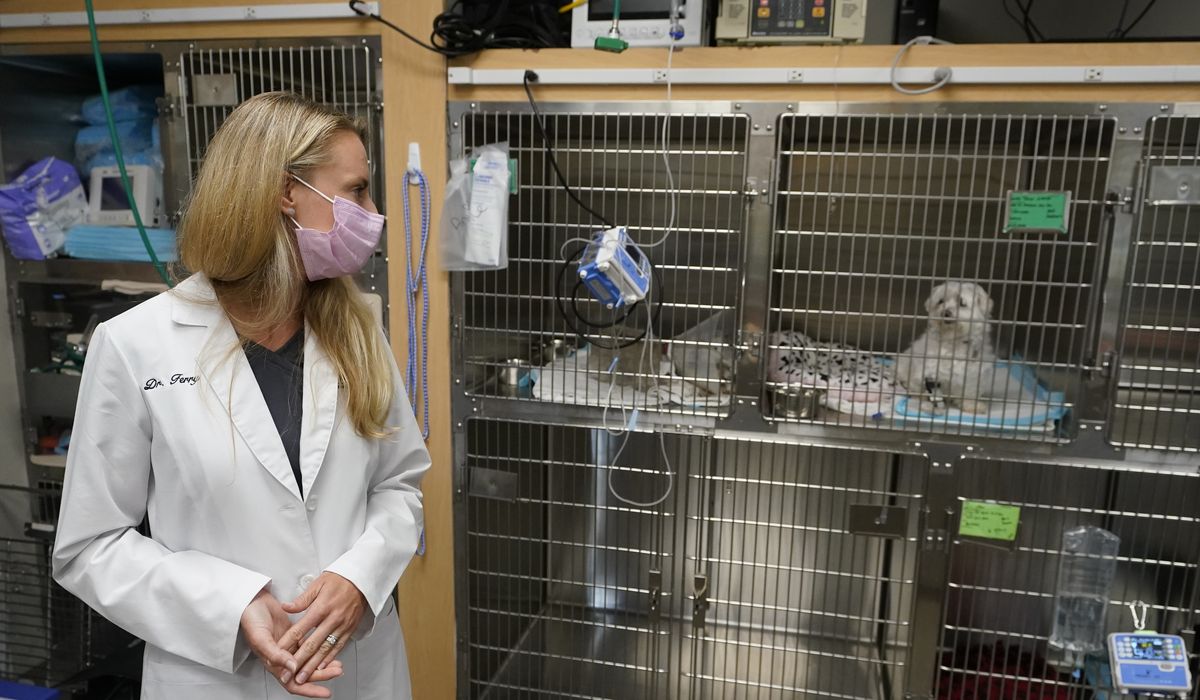
More pets, but not enough trained staff to medically care for them — that’s an issue veterinarians across the country are dealing with.
Veterinarians are wrangling with a heightened demand for their services as a result of the pet adoption boom during the COVID-19 pandemic and staff shortages in some areas as baby boom-era vets retire, others leave the profession due to burnout and veterinary schools fall short of graduates to fill open positions.
To try to meet demand, veterinary clinics have refused to take new patients, tried to hire more staff or extended service hours. Pet owners are finding they have to wait longer to secure an appointment for their pets, even as veterinarians see patients back-to-back.
“We’re slammed all day, every day,” said Jen Reiller, office manager of the Del Ray Animal Hospital in Alexandria, Virginia.
Although the clinic is accepting new patients, she said pet owners must wait about two weeks to get an appointment. Before the pandemic, they were usually able to book same-day appointments.
The Del Ray Animal Hospital is trying to hire a new veterinarian but has been unable to. The animal hospital currently has three veterinarians but needs four, Ms. Reiller said.
She said the clinic daily is seeing about 10 to 12 more new patients, mainly puppies, compared to before the pandemic. The clinic sees between 40 and 60 animals a day, according to Ms. Reiller.
About 12.6 million U.S. households adopted a pet last year after the pandemic was declared in March, The Associated Press reported, citing a study by the American Pets Products Association (APPA).
An estimated 84.9 million U.S. households owned a pet between 2019 and 2020, an APPA survey found, compared to 79.7 million from 2015 to 2016.
Experts also say fewer people last year relinquished their pets, which need ongoing care.
A number of factors have contributed to the increased demand for veterinary services, including that many pet owners are catching up with annual checkups and other postponed preventive care, said Michael San Filippo, a spokesperson for the American Veterinary Medical Association (AVMA).
“Owners are doing more for their pets during each veterinary visit, perhaps because they have more funds available due to less spending on things like dining out and travel during the pandemic,” Mr. San Filippo said.
Pet owners could be noticing more health problems because they are spending more time with their pets at home, he added.
A recent AVMA survey found that the number of patients a veterinarian typically sees in an hour declined 25% in 2020 from previous years because of increases in the amount of time needed to see each patient. Wait times rose from an average of 11 minutes in 2019 to 20 minutes in 2020, according to Mr. San Filippo.
While people took the same number of trips to the vet in 2020 as in 2019, that changed in the first half of 2021, as vets saw a 2.1% increase, according to data compiled by the AVMA and VetSuccess, a veterinary data and marketing firm.
“This growth in visits combined with the impacts to productivity greatly affects how busy practices and veterinary care teams are feeling right now,” Mr. San Filippo said.
Despite the overall data, individual clinics across the country are reporting an uptick in demand and visits from more clients.
Banfield Pet Hospital, a national provider of preventive veterinary medicine, reported about half a million more pet visits last year than in 2019. Its telehealth service also more than doubled in daily volume from March through the end of 2020.
The company said 9.2% more young dogs and 12.4% more young cats were brought to its veterinary clinics last year than in 2019, the first increase in a decade.
The animal hospital last year estimated that 75 million pets in the U.S. could not receive the veterinary care they need by 2030, partially due to the shortage of trained professionals.
In San Diego, Rancho Bernardo Pet Hospital is seeing more clients. Dr. Jatain Sondhi, veterinarian and clinic owner, said the animal hospital saw about 200 new patients last month and about 150 during the pandemic, compared to about 75 new patients each month before COVID-19 hit.
In addition, Dr. Lesa Staubus, a veterinarian for American Humane’s Rescue Team, noted that many regions are facing a shortage of veterinarians as pet ownership rises.
Even before the pandemic, veterinarians struggled to meet demand with the industry growing at a rate that can’t catch up with the need for pet care, experts say.
Dr. Jim Lloyd, former dean of the University of Florida veterinary college, estimates a growing annual shortage of about 3,000 to 5,000 veterinarians, Today’s Veterinary Business reported in February.
The current available supply of veterinarians varies across the U.S., with rural and farm animal veterinary medicine most typically facing a labor shortage and excess demand, Mr. San Filippo noted.
Even before COVID-19, the Del Ray Animal Hospital had been understaffed for years. Ms. Reiller said no one has filled the open veterinarian position for about five years.
Conversely, Rancho Bernardo Pet Hospital has been able to hire more staff.
Dr. Sondhi said he was able to hire a new veterinarian, two vet assistants, a receptionist and a technician over the last few months to address the increase in demand.
He said his clinic grew because some long-time veterinarians in the area shuttered their practices over concerns about contracting COVID-19 as pet adoptions “went through the roof.”
As more people spend more time at home with their pets and notice their ailments, Dr. Sondhi said people feel responsible for tending to them.
“People feel morally and ethically obligated to fix those problems because they have realized that the pets have brought so much joy to their lives,” he said.
• This article is based in part on wire service reports.







